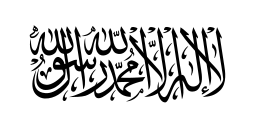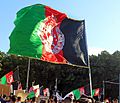Flag of Afghanistan facts for kids
 |
|
| Name | Afghan |
|---|---|
| Proportion | 2:3 |
| Adopted | January 4, 2004 |
| Design | A vertical tricolor of black, red, and green charged in the center with the national emblem |
The flag of Afghanistan (Persian: بيرق افغانستان, Pashto: د افغانستان بيرغ) started to be used on January 4, 2004. This flag has three stripes of the colors black, red, and green. These colors have been on most flags of Afghanistan for many years. The symbol in the middle is the classic emblem of Afghanistan. It shows a mosque with its mihrab (a special niche) pointing towards Mecca.
Afghanistan has changed its national flag more often than almost any other country in the world during the 20th century. It has had 20 different flags since its first flag in 1747. In just four years (1926–1930), Afghanistan had seven flag changes! Many of these flags were used for only a few months.
Contents
A Journey Through Afghanistan's Flags
Afghanistan's flags tell a story of its history, showing changes in its rulers and governments. Let's look at some of the most important flags and what they meant.
Early Flags: Empires and Emirs
From 1747 to 1826, the Durrani Empire used a simple black flag. After that, for a long time, there was no official flag. Then, starting in 1880, the Emirate of Afghanistan began using a black flag with a white symbol. This symbol changed over time, becoming more detailed. For example, Habibullah Khan added a seal that looked like the modern national emblem.
Flags of the Kingdom: New Beginnings
In 1919, under Amanullah Khan, Afghanistan's flag changed. It was black with a white symbol surrounded by rays, like a star. This showed a new start for the country. When Afghanistan became a kingdom in 1926, the flag changed again. It kept the black color but had a new symbol.
A big change happened in 1928. The flag became a tricolor with black, red, and green stripes. These colors were chosen to represent different things:
- Black stood for the past and earlier flags.
- Red represented the blood shed for independence, especially in the Third Anglo-Afghan War.
- Green symbolized hope for the future.
This design was likely inspired by Amanullah Khan's travels in Europe.
Times of Change: Republics and New Ideas
After the kingdom, Afghanistan became a republic in 1973. The flag kept the black, red, and green stripes. The meanings of the colors were explained again: black for the past, red for independence, and green for a good future from farming. A new symbol was added, showing an eagle, a pulpit (from a mosque), and wheat.
In 1978, a communist government took over. For a short time, the flag was red with a yellow symbol, which was common for communist countries. This symbol included a star and the word 'Khalq' (meaning 'people').
Return to Tradition: The Modern Flag
Later, the black, red, and green stripes came back. These colors were again linked to the past, independence, and the Islamic faith. The symbols in the middle continued to change, often showing things like a rising sun, a mosque, or symbols of industry.
From 1992 to 1996, and again in 2001, the flag had green, white, and black stripes. These colors are often seen on flags of Muslim nations. The flag also included important Islamic phrases like "Allahu Akbar" (God is great) and the Shahadah (a declaration of faith).
During the Taliban rule (1996-2001), the flag was plain white, and later, the Shahadah was added to it.
The flag we see today, adopted in 2004, is very similar to the one used between 1930 and 1973 during the monarchy. It has the black, red, and green vertical stripes with the national emblem in the center. The emblem now includes the year 1919, which marks Afghanistan's independence from Great Britain.
Images for kids
-
Afghan flag hanging over the Afghan Embassy in Bonn, Germany
-
Afghan flags during the handover of Lashkargah (2011)
-
Flags being flown during an anti-Taliban demonstration in Berlin, Germany (2021)
See also
 In Spanish: Bandera de Afganistán para niños
In Spanish: Bandera de Afganistán para niños



































